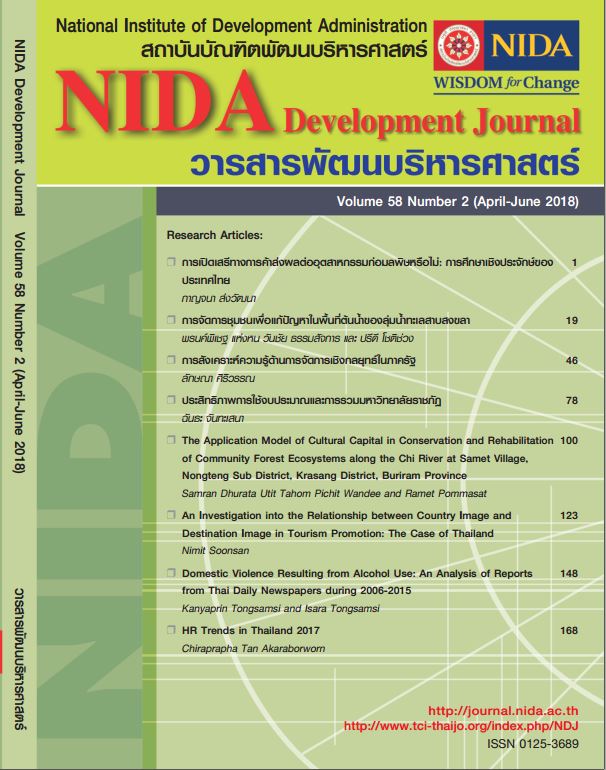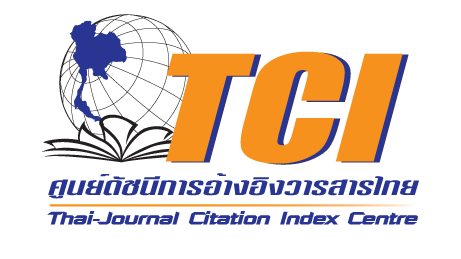Expenditure Efficiency and Rajabhat University Mergers
Keywords:
Merger, Qaulity Assurance, Budget, Cost, Efficiency and UniversityAbstract
Higher education in Thailand is facing declining demand from prospective students. The 38 Rajabhat Universities are not only decreasing demand for study but also increasing of government spending more than 100% compared 2007 to 2017. In this study, we estimate the Rajabhat University-level cost efficiency relative to cost frontier of Rajabhat University using Data Envelopment Analysis of 38 Rajabhat Universities for 2014 and 2015. We use Tobit model to study the relationship between the size of university and cost efficiency scores.
The result shows that the cost of many Rajabhat Universities trend to inefficiency. Suratthani and Suansunandha Rajabhat University are the best cost efficiency in 2014 and 2015, respectively. Tobit model shows that size is significantly positively related to cost efficiency scores. For coping with demand problem for Rajabhat University that should increase in size of Rajabhat university. We propose that inefficiencies Rajabhat Universities should be considered to merge.
References
จังหวัดเพชรบุรีด้วยวิธีการ DEA และ WPF-DEA. วารสารการจัดการสมัยใหม่, 11(2): 81-101.
สำนักงานคณะกรรมการการอุดมศึกษา. (2556). แผนพัฒนาการศึกษาระดับอุดมศึกษา ฉบับที่ 11 (พ.ศ.
2555-2559). โรงพิมพ์แห่งจุฬาลงกรณ์มหาวิทยาลัย, กรุงเทพฯ.
สำนักงานคณะกรรมการการอุดมศึกษา. (2558). คู่มือการประกันคุณภาพการศึกษาภายในระดับอุดมศึกษา
พ.ศ. 2557. ห้างหุ้นส่วนจำกัดภาพพิมพ์, กรุงเทพฯ.
ภาวิช ทองโรจน์. (2554). 10 อาการที่ทำให้ต้องผ่าตัดใหญ่การศึกษาไทย. เข้าถึงเมื่อ 24 สิงหาคม 2554.
https://www.jobpub.com/articles/showarticle.asp?id=3241
ภาวิช ทองโรจน์. (2560). ศ.พิเศษ ดร.ภาวิช ทองโรจน์ เจาะ 40 ปีการศึกษาไทย เป๋ไปเป๋มาดิ่งลงเหว. นสพ.
ประชาชาติธุรกิจ ฉบับ 9 มกราคม 2560 เข้าถึงเมื่อ 14 มิถุนายน 2560. http://www.prachachat.net/news_detail.php?newsid=1483968178.
Aigner, D.J., Love, C.A.K. & Schmidt, P. (1977). Formulation and estimation of stochastic
frontier production function models. Journal of Econometrics, 6: 21-37.
Athanassopoulos, A. D., & Shale, E. (1997). Assessing the comparative efficiency of higher
education institutions in the UK by means of data envelopment analysis. Education Economics, 5(2): 117-134.
Aula,H-M. & Tienari, J. (2011). Becoming “world‐class”? Reputation‐building in a
university merger. Critical perspectives on international business, 7(1):7-29,
Banker, R.D., Charnes, A & Cooper, W.W. (1984). Some models for estimating technical and
scale inefficiencies in data envelopment analysis. Management Science, 30(9):
1078–1092.
Banker, R., & Natarajan, R. (2004). Statistical tests based on DEA efficiency scores. In: Cooper,
W.W., Seiford, L., Zhu, J. (Eds.), Handbook on Data Envelopment Analysis. Kluwer Academic Publishers, Norwell, MA, 299–321.
Bonaccorsi A., & Daraio C. (2005). Exploring size and agglomeration effects on public research
Productivity. Scientometrics, 63(1): 87–120.
Brinkman, P. T. & Leslie, L. L. (1986). Economies of scale in higher education: sixty years of
Research. Review of Higher Education, 10: 1- 28.
Brandt T. & Schubert T. (2014). Is the University Model an Organizational Necessity? Scale
and Agglomeration Effects in Science, in Bonaccorsi A. (ed.), Knowledge, Diversity and Performance in European Higher Education, Cheltenham, Edward Elgar, 233- 266.
Carayol, N., & Matt, M. (2006). Academic. Individual and collective determinants of scientists’
Productivity. Information Economics and Policy, 18(1): 55-72.
Charnes, A., Cooper, W.W & Rhodes, E. (1978). Measuring the efficiency of DMUs. European
Journal of Operational Research, 2: 429-444.
Coelli T., Rahman S., & Thirtle, C. (2002). Technical, allocative, cost and scale efficiencies in
Bnagladesh rice cultivation: A non-parametric approach. Journal of Agricultural Economics, 53: 607–626.
Cohn, E., & Cooper, S. T.(2004). Multiproduct cost functions for universities: economies of
scale and scope’ in Johnes, G and Johnes, J (Eds) International Handbook on the Economics of Education Edward Elgar: Cheltenham
Daraio, C., Bonaccorsi, A. & Simar, L. (2015). Efficiency and economies of scale and
specialization in European universities: A directional distance approach. Journal of Informetrics, 9(3): 430-448.
Farrell, M. (1957). The measurement of productive efficiency. Journal of the Royal Statistical
Society, Series A, 120: 253–281.
Flegg, A. T., Allen, D. O., Field, K., & Thurlow, T. W. (2004). Measuring the efficiency of British
universities: a multi-period data envelopment analysis. Education Economics, 12(3):
231 – 249.
Glaeser, E.,L., La Porta, R., Lopez-de-Silanes, F. & Shleifer, A. (2004). Do institute cause growth.
Journal of Economic Growth, 9(3): 271-303.
Gillard, E., Saunders, S., Terblanche, J. & Sukel, M.(2012). A review of four case studies in
restructuring the South African Higher Education System, Retrieved 2 June 2017, from http://ahero.uwc.ac.za/index.php?module=cshe&action=downloadfile&fileid=18409092513343937939456
Hallak, Jacques, & Poisson, Muriel. (2007). Corrupt schools, corrupt universities: What can be
done? Paris: Institute for International Educational Planning.
Harman,K. & Meek,V.L. (2002) Introduction to special issue: Merger revisited: international
perspectives on mergers in higher education. Higher Education, 44. 1–4.
Hashimoto, K. & Cohn, E. (1997). Economies of scale and scope in Japanese private
universities. Education Economics, 5: 107-116.
Horta, H., & Lacy, T. A.(2011). How does size matter for science? Exploring the effects of
research unit size on academics’ scientific productivity and information exchange
behaviors. Science and Public Policy, 38(6): 449-460
Johnes, G., Johnes, J. & Thanassoulis, E. (2008). An analysis of costs in institutions of higher
education in England. Studies in Higher Education, 33 (5): 527-549.
Johnes, J. (2006). Data envelopment analysis and its application to the measurement of
efficiency in higher education. Economics of Education Review, 25: 273-288.
Johnes, J. (2008): Efficiency and productivity change in the English higher education sector
from 1996/97 to 2002/03. The Manchester School, 76(6): 653-674.
Koshal, R. K., & Koshal, M. (1999). Economies of scale and scope in higher education: a case
of comprehensive universities. Economics of Education Review, 18: 269–277.
Laband, D. N., & Lentz, B. F. (2003). New estimates of economies of scale and scope in higher
education. Southern Economic Journal, 70.
Mapasela, M. & Hay, H.R., (2005). Through the magnifying glass: A descriptive theoretical
analysis of possible impact of the South African higher education policies on academic staff and their job satisfaction. Higher Education, 50: 111– 128.
McMahon, W.W. (2010). The external benefits of education. In Brewer, D.J. & McEwan, P.J.
(Eds.), Economics of Education (pp. 68-79). San Diego, CA: Elsevier.
Meeusen, W. & van den Broeck, J. (1977). Efficiency estimation from Cobb-Douglas
production functions with composed error. International Economic Review 18:
435-444.
Pruvot, E.B., Estermann, T. & Mason, P. (2015). Define thematic report: University mergers in
Europe. European University Association. Lifelong Learning programme of the European Union.
Simar, L. & Wilson, P. (2011). Inference by the m out of n bootstrap in nonparametric frontier
models. Journal of Productivity Analysis, 36: 33–53.
Thanassoulis, E., M. Portela & Despic,O. (2008). The mathematical programming approach to
efficiency analysis. In H. Fried, K. Lovell, S. Schmidt (Eds.), Measurement of Productive Efficiency and Productivity Growth. Oxford University Press
Wikipedia. (2017). List of university and college mergers in the United States. Retrieved
Sebtemner 24, 2017, from Website.https://en.wikipedia.org/wiki/List_of_university_and_college_mergers_in_the_United_States
Worthington, A. (2001). An empirical survey of frontier efficiency measurement techniques in
Education. Education Economics, 9(3): 245-268.
Wyngaard, A. & Kapp, C.(2004). Rethinking and reimagining mergers in further and higher
education: A human perspective. South African Journal of Higher Education 18(1): 185–201.
TRANSLATED THAI REFERENCES
Pasunon, P. & Tragantalerngsak, S. (2013). Efficiency evalution of agricultural cooperative in
Phetchaburi province with DEA and WPF-DEA approaches. Modern Management Journal, 11(2): 87-101. (in Thai)
Office of higher education commission. (2013). The 11th higher education development plan
(2012-2016). Chulalongkorn University Printing House, Bangkok. (in Thai)
Office of higher education commission. (2015). Manual for The Internal Quality Assurance for
Higher Education Institutions. Parbpim Ltd., Part. Bangkok. (in Thai)
Tongroach, P. (2011). 10 sign for Thailand educational revolution. Retrieved August 24, 2011,
from Website. https://www.jobpub.com/articles/showarticle.asp?id=3241 (in Thai)
Tongroach, P. (2017). Professor Pavich Tongroach focus on 40 year of Thailand education
collapse. Prachachart Turakij online, 9 January 2017. Retrieved June 14, 2017, from Website. http://www.prachachat.net/news_detail.php?newsid=1483968178. (in Thai)





